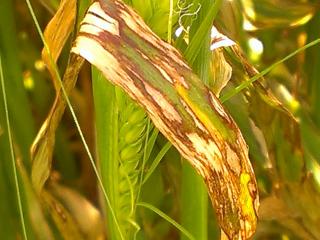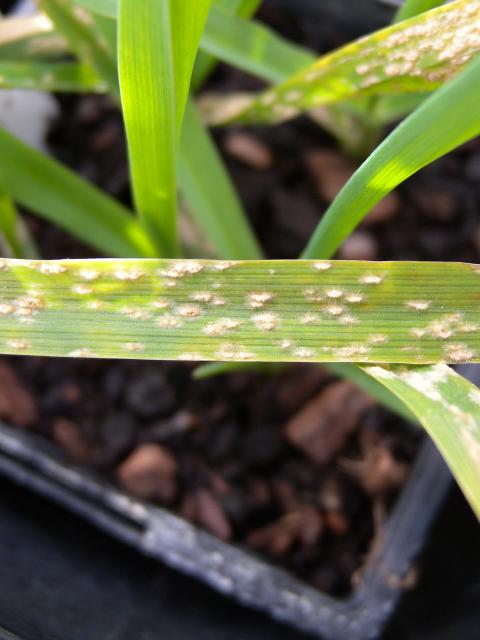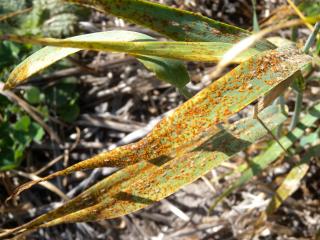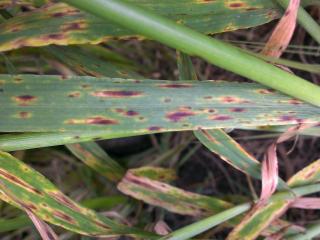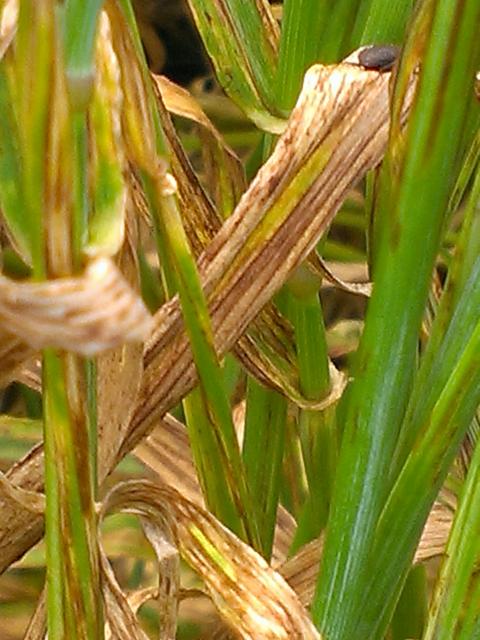Integrating disease management for barley
For effective disease management, it is important to use a combination of practices that focus on the factors affecting disease (Table 1). Over-reliance on any one factor to control common foliar diseases, such as fungicide alone, will not be as effective or sustainable as an integrated management approach.
Variety choice and implications for disease management
Grain quality and agronomic adaptation often determine the choice of variety. Knowing the responses of your variety to disease (for example, resistance or susceptibility) will help to determine the need for other disease management approaches. Resistance profiles of barley varieties grown in WA vary across the spectrum of diseases. Current malting varieties are generally more susceptible than feed varieties. See the annual Crop Sowing Guide for Western Australia for information on the response of current varieties to foliar disease.
| Disease | Cultivar resistance | Crop rotation | Stubble destruction | Disease-free seed | Chemical# seed | Chemical# foliar |
|---|---|---|---|---|---|---|
| Scald | 1 to 3 | 1 | 1 | 2 | 2 | 1 |
| Spot-type net blotch | 1 to 3 | 2 | 1 | 3 | 1 | 2 |
| Net-type net blotch | 1 to 3 | 2 | 1 | 2 | 1* | 2 |
| Powdery mildew | 1 to 3 | 3 | 3 | 3 | 2 | 1 |
| Barley leaf rust | 1 to 3 | 3 | 3 | 3 | 2** | 1 |
| Barley yellow dwarf virus | 1 to 2 | 3 | 3 | 3 | 2 | 2 |
Key: 1 = very effective, 2 = moderately effective, 3 = not effective
# Fungicide use is indicated except for barley yellow dwarf virus for which insecticide use is indicated.
* Several seed dressings are registered to control seed-borne net-type net blotch.
** No fungicide registered at the time of publication.
Fungicide disease management
Fungicide at seeding
Fungicide seed dressings or fungicides applied in-furrow with fertiliser can be useful in disease protection or suppression of early seedling infection. The recently released seed dressing fungicide Systiva® (fluxapyroxad) is registered for the control of both STNB and NTNB. It provides systemic protection and may reduce the need for a first foliar fungicide at tillering to stem extension. The length of protection provided by this fungicide and any yield response will be dependent on inoculum load, variety susceptibility and seasonal conditions. The choice of fungicide should be determined by the target diseases, fungicide resistance status and information on seed dressing and in-furrow fungicides for cereals in WA.
Foliar fungicide
The aim of foliar fungicide application in the crop is to delay disease development and to maintain green leaf area which reduces disease impact on yield and grain quality. In barley, the most important contributors to yield are leaf two (flag-1), leaf three (flag-2), the ear and upper stem, while the flag leaf is relatively unimportant. Protecting leaf two and leaf three is the highest priority in effective disease control.
The cost effectiveness of foliar fungicide applications depends on disease severity, susceptibility of the variety, yield potential of the crop, grain quality outlook and the environment where the crop is growing.
Reliance on fungicide is much greater in medium to high rainfall areas than in low rainfall regions due to higher disease pressure and longer growing seasons during which the disease epidemic may increase. For instance, in the medium rainfall region a single application of fungicide may be required at late stem elongation to flag leaf emergence stage (Z33-39). In a long season, high rainfall area two fungicide sprays are often required: one at early stem elongation and a follow-up spray at or just prior to flag leaf emergence. When susceptible varieties are grown in conditions favourable for disease development, such as disease prone areas or high rainfall seasons, fungicide can be cost effective in reducing the disease impact where yield potential is over 2.0t/ha. Under high disease pressure, using higher fungicide rates will give longer residual protection. The choice of fungicide should be determined by the target diseases, fungicide resistance status and information on registered foliar fungicides for cereals in WA.
Rotation and stubble management
Diseases such as scald, spot-type net blotch and net-type net blotch are stubble borne. Paddock selection is important to minimise stubble-borne diseases. Crop rotation with a non-host crop in the previous year will minimise initial inoculum levels for the current season's crop. To further reduce disease pressure, avoid sowing the current season's crop in paddocks adjoining those with barley stubble from the previous season. Cultural practices such as incorporating the residue into the soil or removing it completely (for example, by burning) will reduce the abundance of the pathogen and the disease pressure. Stubble may be reduced by baling and grazing; however, these methods only result in a small reduction in the disease pressure. Stubble reduction must be balanced against the increased risk of soil erosion by wind or water.
Green bridge management
Three major diseases, barley leaf rust, powdery mildew and barley yellow dwarf virus (BYDV), persist on living hosts. Barley leaf rust survives on barley volunteers, powdery mildew on barley volunteers and stubble, and BYDV on cereal regrowth and perennial grasses. A green bridge of self-sown barley leading into the cropping season provides host material for these diseases and the aphid vector of BYDV and increases the risk of their early onset. Removing this green bridge as early as practicable before seeding will greatly reduce the risk of early crop infection. Further information is available on control of green bridge for pest and disease managment.
Seed health
The foliar diseases scald and net type net blotch and the head diseases loose smut and covered smut can be seed-borne. Sowing infected seed can introduce disease into a new crop. Therefore clean seed should be used wherever possible. Fungicide seed dressings can reduce the risk associated with sowing infected seed, particularly for smuts and bunts. See seed dressing and in-furrow fungicides for cereals in WA for further information.
In addition, barley yellow dwarf virus (BYDV) is a threat in aphid prone areas.
Other causes of leaf spotting in barley
It is important to remember that abiotic factors such as nutrient deficiencies or adverse weather conditions can also cause abnormalities in barley leaves. Some barley genotypes exhibit varying degrees of physiological spotting on leaves which can also be confused with disease symptoms.
An important starting point in disease management is correct identification as diseases differ in their best management strategies. See specific disease pages on this site for symptoms and effects. Further assistance with disease identification can be obtained from DDLS - Plant pathology services.
Scald
Scald (Rhynchosporium commune) is a stubble- and seed-borne disease which is favoured by high rainfall environments. Generally, this disease is most damaging in the high rainfall, southern regions but severe epidemics have been observed in medium rainfall areas under favourable conditions. Details and more photos of the symptoms of scald are available on the MyCrop page.
Control
- Sowing resistant varieties where possible is the most effective strategy. For medium to low rainfall areas, avoid very susceptible (VS) varieties. For high rainfall areas, sow moderately resistant (MR) and resistant (R) varieties.
- Rotating crops (for example, a break of one year) between barley crops will significantly reduce the potential for serious disease.
- Sow clean seed harvested from an uninfected crop.
- A seed dressing or in-furrow fungicide should be used in medium to high rainfall areas or if the seed is from an infected crop.
- Applying a fungicide spray is necessary in medium to high rainfall regions where disease threatens crops that have high yield and quality expectations. Apply fungicide before head emergence if hot spots within the crop are frequently observed during stem elongation or active infections are present on middle canopy leaves.
Powdery mildew
Powdery mildew (Blumeria graminis f.sp. hordei) occurs throughout the agricultural areas but is more common in southern regions where high humidity favours disease development. Severe infections can occur in winter months during the early stages of the crop growth, thus affecting yield potential through tiller abortion (up to 25% yield loss). New leaves that emerge later in the season are generally less severely infected as conditions become less favourable to the disease. This may not be the case in high production situations (such as high rainfall or humid coastal areas) where high seed rates or heavy application of nitrogen fertiliser have been used. Severe infection at later stages (after Z39) can cause 5-13% yield loss. A powdery mildew infected crop will appear yellow from a distance, similar to a crop suffering from water logging or nutrient deficiency. Therefore, close examination is needed. Details and more photos of the symptoms of powdery mildew are available on the MyCrop page.
Control
- Using resistant varieties will minimise the impact of powdery mildew and most economical way to manage the disease. Some current malting varieties such as Granger, Flinders and Scope CL and some feed varieties such as Dash and Oxford grown in WA are resistant to powdery mildew. See the Crop Sowing Guide for disease resistance profile.
- Cultural control such as eradication of regrowth barley which harbour inoculum, disposal of infected stubbles, avoiding early sowing and avoiding use of excess nitrogen fertiliser application will help to reduce the disease.
- A seed dressing fungicide containing fluquinconazole applied as a standard treatment for susceptible varieties is usually sufficient to minimise early disease development and limit the yield loss caused by powdery mildew in medium to high rainfall areas. The duration of early protection depends on the amount (grams per tonne of grain) of active ingredient applied to grain. Higher rates will increase the duration of protection. In-furrow application with fertiliser allows the use of higher rates of fungicide than direct seed application, however fungicide resistance has diminished the control provided by flutrifol and triademfon in-furrow.
- In situations where varieties susceptible to powdery mildew are sown without seed dressings, it is important to spray the crop if there are early signs of mildew, especially during the tillering stage. Application of foliar fungicides is most economical in high risk areas or in regions with high yield or quality expectations. For greatest efficacy, fungicides should be applied before significant levels of disease establish in crop. Use the fungicide to protect the crop rather than attempt to recover the crop. The first foliar fungicide spray may coincide with post-emergent herbicide application at tillering. A second spray may be warranted before head emergence, three to four weeks after the first spray, if active infections are visible on leaves which have emerged subsequent to the first fungicide spray.
- Due to the development of fungicide resistance in the powdery mildew pathogen there are special considerations on which up-front and foliar fungicides are used for powdery mildew control. Tebuconazole based fungicides should not be used in any areas due to being compromised by fungicide resistance. In high powdery mildew risk, high rainfall areas such as south coast of WA, triadimefon and tebuconazole single active base products are not recommended. Epoxionazole, Propiconazole, Propiconazole + Cyproconazole, Propiconazole + Tebuconazzole, Tebuconazole + Prothiconazole base single actives or mixtures can be use in managing powdery mildew. The fungicide mixtures currently registered in WA which containing strobilurins (Cyproconazole + Azoxystrobin, Tebuconazole + Azoxystrobin, Epoxiconazole + Azoxystrobin and Epoxiconazole + Pyraclostrobin) are recommended to use only one application for a season as part of the fungicide resistance management strategies. See Management of barley powdery mildew in the face of fungicide resistance for further information.
- Barley growing on potassium deficient soil (K <50ppm) is more susceptible to powdery mildew. Consider applying potassium fertiliser, preferably muriate of potash 20-50kg/ha (or sulfate of potash 44-97kg/ha), four weeks after seedling emergence in order to reduce the powdery mildew and increase yield. Muriate of potash has been found to be significantly better than sulfate of potash in aiding powdery mildew control.
Barley leaf rust
Barley leaf rust (Puccinia hordei) has developed into a recurring threat since the occurrence of pathotypes in 1997 that infect Franklin and Gairdner. It is an aggressive and difficult foliar disease to control and can be a recurring problem in crops in the southern high rainfall zones. Early disease risk is high when there is volunteer barley (green bridge) harbouring this rust over summer. Barley leaf rust frequently causes yield and quality losses. In seven field experiments from 2002-2006, application of fungicide to infected plants resulted in yield improvement ranging from 3-145% (mean yield improvement of about 33%) depending on the time of disease onset, fungicide product, rate and time of application. The yield benefits were accompanied by large reductions in screenings and improved grain colour. Details and more photos of the symptoms of barley leaf rust are available on the MyCrop page.
Control
- Sowing resistant varieties is the most economical way to control the disease. Most of the current malting varieties are susceptible (S) except for Granger (R/MR) but there are some resistant (R) feed varieties such as Oxford. The detection of new leaf rust pathotype 5457P in 2013 on the south coast indicates most the barley varieties with Rph3 gene are now vulnerable and now should be treated as susceptible. These varieties such as Bass need to be managed with fungicides in the presence of the disease. Experiments conducted in to south coast during 2014/15 indicate that varieties such as Flinders which possess slow rusting genes also known as adult plant resistant genes (APR), such as Rph20, are moderately resistant to the new leaf rust pathotype. See the Crop Sowing Guide for disease resistance profile.
- Minimise green bridge risk by grazing or applying herbicide to remove any volunteer barley which emerges following summer or autumn rains.
- Many of the seed dressing or in-furrow fungicides registered for control of other barley diseases have been shown to be effective in preventing early leaf rust infection under experimental conditions, but they are not currently registered for this use.
- Apply fungicide spray if disease threatens well grown crops. Where an early outbreak of leaf rust in barley occurs, the initial spray should be applied at the onset of the disease and followed by a second application three to four weeks later. Early foliar fungicide sprays are more effective than seed dressing or in-furrow fungicide application for control of early infections of barley leaf rust.
More information can be found on the implications of the latest new barley leaf rust pathotype found in WA.
Spot-type net blotch
Spot-type net blotch (Pyrenophora teres f.sp. maculata) occurs state-wide but is most damaging in south coastal and neighbouring medium to high rainfall regions where it can have severe yield and quality effects. This disease is stubble-borne so is more severe where barley is grown year after year in the same paddock. In high disease situations in the southern high rainfall region, more than 35% yield loss has been observed. In addition, current research indicates that every 10% increase in leaf area lost to this disease on the top three leaves accounts for 0.4t/ha yield loss. Outbreaks can also occur in central and northern agricultural areas. Details and more photos of the symptoms of spot-type are available on the MyCrop page.
Control
- Avoid sowing susceptible (S) and very susceptible (VS) varieties, particularly in high production situations.
- A one-year break between barley crops in a paddock will markedly reduce the potential for serious disease. If highly effective stubble retention systems are in use, a two-year break may be required.
- The recently released seed dressing fungicide Systiva® (fluxapyroxad) is registered for the control of both STNB and NTNB. It provides systemic protection and may reduce the need for a first foliar fungicide at tillering - stem extension.
- Applying a fungicide spray is necessary in medium to high rainfall regions where disease threatens crops with high yield and quality expectations. The choice of a single-spray or two-spray strategy depends on the environment in which the crop is growing.
- In high rainfall environments it may be necessary to apply two sprays, such as at early stem elongation stage with a follow-up spray three to four weeks later.
- In medium rainfall regions, consider one well timed spray between late stem elongation and early flag leaf emergence (Z33 - 39) to protect leaf two (flag-1). Under high disease pressure, best results may be obtained by using the maximum recommended rates.
Further information is available on Managing net-type and spot-type net blotch in barley and Managing spot-type net blotch in continuous barley.
Net-type net blotch
Net-type net blotch (Pyrenophora teres f. teres) disease occurs throughout the barley growing areas of Western Australia including the medium and low rainfall areas. This disease can be both stubble- and seed-borne. Infection and spread of this disease is favoured by wet conditions and it is most evident following periods of rainfall. It will cause the greatest yield loss in paddocks that are re-sown to barley without a break-crop. Details and more photos of the symptoms of net-type net blotch are available on the MyCrop page.
Control
- Effective control practices for this disease are the same as those described above for spot-type net blotch, along with the additional strategy below.
- If seed-borne net-type net blotch is suspected, seed can be sent to DAFWA's Diagnostic Laboratory Services for seed for diagnosis prior to seeding. If seed is infected, treating it with a fungicide registered for suppression of seed-borne net-type net blotch can reduce seed to seedling transmission. However, this method of spread is not considered important in the overall level of infection by this disease in barley crops in Western Australia. See the Seed dressing and in-furrow fungicides for cereals page for further information.
Further information is available on Managing net-type and spot-type net blotch in barley.
Barley yellow dwarf virus
Barley yellow dwarf virus (BYDV) causes stunting of barley plants and subsequent loss of yield and quality. BYDV can be damaging in the high and very high rainfall areas of the south-west or, more rarely, in nearby medium rainfall areas. BYDV is spread from infected grasses and volunteer cereals to barley by cereal aphids. The greatest risk of significant yield and quality effects is from early infection during the first 8-10 weeks of crop growth. Risk of early aphid arrival largely depends on the amount of summer and autumn rainfall and the availability of green vegetation before the growing season. Details and more photos of the symptoms of barley yellow dwarf virus are available on the MyCrop page.
Control
- Sow varieties that are less susceptible to BYDV. Variety resistance is an effective management option in high risk locations.
- Applying a seed dressing containing imidacloprid (for example, Hombre®, Zorro®), or spraying the crop with registered insecticides in the first 3-7 weeks of crop growth, can substantially reduce BYDV infection. Growers need to assess BYDV risk each season for their location and time of sowing to determine the most appropriate insecticide application strategy.
- Further information is available from the page Managing barley yellow dwarf virus and cereal yellow dwarf virus in cereals.
More information is available on Managing barley dwarf virus.
Wheat streak mosaic virus
Barley is a host for wheat streak mosaic virus (WSMV) but this disease is not currently considered to be yield or quality limiting in barley. More information on the symptoms is available on the MyCrop page and information on managing it and the wheat curl mite on the Wheat streak mosaic virus and wheat curl mite page.
Other leaf diseases
Ring spot (Pyrenophora semeniperda), halo spot (Selenophoma doncis) and Wirrega blotch (Pyrenophora wirreganensis) do not normally require specific control measures.
Disease diagnosis
It is important to remember that abiotic factors such as nutrient deficiencies or adverse weather conditions can also cause abnormalities in barley leaves. Some barley genotypes exhibit varying degrees of physiological spotting on leaves which can be confused with disease symptoms. An important starting point in disease management is correct identification as diseases differ in their best management strategies. Further assistance with disease identification can be obtained from DDLS - Plant pathology services.
Disclaimer: Mention of trade names does not imply endorsement or preference of any company's product by Department of Agriculture and Food, Western Australia, and any omission of a trade name is unintentional. Recommendations are current at the time of page preparation.




